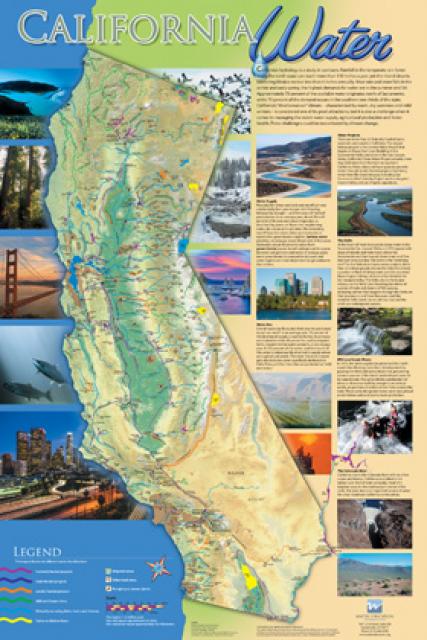California Project WET Gazette
Summer 2025
Water’s In, Water’s Out!
The new Project WET Water in Earth Systems guide is now published and began rolling out in California Project WET workshops at the end of April. The guide will be featured in all the summer educator institutes that are incorporating Project WET. It features several new activities among updated versions of many favorites. This article bears one of these new activity titles, which conjures thoughts of hamburgers from a popular chain!
Instead, Water’s In, Water’s Out! engages students in exploring the concept of a hydrological budget. This is a very timely topic in California where heated debates over water scarce regions looking to water abundant regions to help balance their hydrological budgets have long grabbed news headlines. Today, the debates include new strategies that are being developed to better conserve and store local water resources and greater emphasis on protecting water for vulnerable communities.
 Water is always moving in and out of watersheds. Examples of this include water entering the watershed through rain or snow and leaving the watershed through evaporation, plants using it through transpiration, or water flowing to another area. Students begin the Water’s In, Water’s Out! activity by brainstorming all the ways they can think of that water can be removed or deposited into a watershed.
Water is always moving in and out of watersheds. Examples of this include water entering the watershed through rain or snow and leaving the watershed through evaporation, plants using it through transpiration, or water flowing to another area. Students begin the Water’s In, Water’s Out! activity by brainstorming all the ways they can think of that water can be removed or deposited into a watershed.
Students then consider this movement of water within the context of common scenarios generated by natural events and human use of water, such as water for agriculture and our homes. Each scenario card gives a brief overview of the importance of the water withdrawal or deposit – and variations for differing climates. Students work in teams to discuss their scenario variations and choose a volume of water to move that is consistent with their location.
The scenarios are put into action as students engage in a physical simulation of the water withdrawals and deposits, where they begin to see that a hydrologic budget is like a bank account for a watershed. Like bank accounts, hydrological budgets include deposits (precipitation or inflow), withdrawals (through plants, evaporation or flowing to another area), savings (like reservoirs for use when water levels are low) and transfers (moving from one watershed to another).
Students analyze the results of the simulation and discuss whether their watershed maintained a reasonable amount of water for the community or if it was out of balance – and what might be a healthy balance if the latter was the case. They also discuss which deposits and withdrawals humans can manage, and which are determined by nature – and how those managed by humans may be used to maintain hydrological balance in times when nature delivers excessive precipitation or drought.
For older students, the final part of Water’s In, Water’s Out! includes a spreadsheet exercise looking at the deposits and withdrawals in a watershed over time. This mathematical model simulation of a watershed looks very much like my own monthly accounting spreadsheet for income and expenses, which allows me to easily identify periods of above average cash flow and overuse just as the water version allows students and real-life hydrologists to observe the same in a hydrological budget.
In the mathematical simulation, students graph the results and look at the patterns of net gain or loss that emerge. Students are asked where excess water in good precipitation years may go in the watershed and where the water may come from in drought years to make up the deficits observed in the data. They are also asked to consider which users should limit or could conserve their water use to make up the difference – all of which are current realities facing California water managers.
Throughout the activity, as students discuss local examples and interact with the simulation models, they learn that each watershed has its own unique water budget. A hydrological budget along California’s northern coast with high precipitation inflows will look very different from a San Joaquin Valley budget more reliant on groundwater withdrawals or budgets in Southern California dependent on transfers from other watersheds.
Students are also learning about the options water managers may use to maintain a hydrological account to sustain users. Sometimes they can add more water by using underground sources, stepping up conservation, building storage areas like reservoirs or recharging aquifers, all of which are scenarios that are not in the activity, but ones that can be written up and added by students to further localize the simulation.
 Water managers can also consider bringing water from another watershed – an interbasin transfer – which is far more complicated than most people think and requires agreements between different groups. Current examples and recurring flashpoints in the news include the Los Angeles Aqueduct and impacts to Mono Lake and the Owens Valley, allocations from the Central Valley and State and Central Valley Water Projects, the divvying up of Colorado River water and the decades long saga of the projects to shuttle more fresh water around the Delta.
Water managers can also consider bringing water from another watershed – an interbasin transfer – which is far more complicated than most people think and requires agreements between different groups. Current examples and recurring flashpoints in the news include the Los Angeles Aqueduct and impacts to Mono Lake and the Owens Valley, allocations from the Central Valley and State and Central Valley Water Projects, the divvying up of Colorado River water and the decades long saga of the projects to shuttle more fresh water around the Delta.
Water’s In, Water’s Out! strives to demonstrate that by carefully tracking water deposits and withdrawals over time, hydrologists can help keep the water budget balanced and sustainable to make sure watersheds have enough of this precious resource for the future. But this has become harder to achieve in California and the southwestern United States where water needs and changing climate patterns have stretched hydrological budgets more often into deficit territory in recent years.
A great extension to Water’s In, Water’s Out! is having students apply the concepts and skills from the activity to develop a hydrological budget model analyzing one of the current issues or a local example that may be easier for younger students to investigate. The Websites of Interest in this Gazette include examples of current hydrological budget wrangling in the news, as well as more detail on the use of hydrological budgets from local to national scales.
I would also encourage anyone without plans to consider attending one of the summer workshops or teacher institutes listed in the Professional Development Opportunities section of this Gazette. You’ll also find a list of upcoming Summer Events and Grant Opportunities to consider for the upcoming school year.
Hope you have a wonderful summer!
WEBSITES OF INTEREST
US Geological Survey: Watersheds and Drainage Basins
A watershed is a precipitation collector. Most of the precipitation that falls within the drainage area of a USGS stream monitoring site collects in the stream and eventually flows by the monitoring site. Many factors determine how much of the streamflow will flow by the monitoring site. However, not all precipitation that falls in a watershed flows out.
KnowYourH2O: The Hydrological Cycle – Water Budgets
The hydrologic budget or water budget for a watershed consists of inflows, outflows, and storage. This is very much like a checking or bank account. There is income (precipitation), spending (runoff and evaporation/ transpiration), savings (recharge/storage/aquifers), and “stealing” from other watersheds (bank transfers). (evaporation and transpiration can be combined as evapotranspiration).
MAVEN’S NOTEBOOK: Where does California’s water come from?
Most of us remember learning about the water cycle, so we can understand easily enough that rain and snow are the ultimate sources of most of our water supply. But what most Californians might not realize is how vast the state’s water infrastructure is that irrigates the farmland and delivers the water to our faucets and how profoundly that infrastructure has remade the state as we know it today.
Sacramento Regional Water Bank: How the Water Bank Works
In the Sacramento region, deposits into the Water Bank happen primarily through natural recharge, in lieu recharge and direct artificial recharge. Withdrawals from the Water Bank happen through a system of groundwater pumps and pipelines, that draw and treat water from the aquifer and then deliver it to homes and businesses.
NASA Jet Propulsion Lab: Modeling the Water Budget
In this activity, students will use California precipitation totals and evapotranspiration data to calculate and graph water deficits and surpluses. These spreadsheet models will help students understand droughts and the movement of water in the water cycle. A great NASA activity to use in tandem with “Water’s In, Water’s Out!”
US Geological Survey: Water Budgets Across the United States
Water budgets are used to understand the movement of water into and out of a watershed. Much like a financial budget, inflows, storage, and outflows can be thought of like income, expenses and account balances respectively. In this data visualization, you can see how major components of the water budget vary across the conterminous US.
PPIC: Tracking Where Water Goes in a Changing Sacramento–San Joaquin Delta
The Sacramento–San Joaquin Delta lies at the confluence of two of the state’s largest rivers and at the head of the San Francisco Estuary. The ecological health of the Delta and the reliability of its water supplies are in decline. Given the challenges facing the watershed and the competing uses for scarce supplies, Delta water management issues are a source of conflict and many misunderstandings about water use.
Maven’s Notebook: EXPLAINER: Delta Conveyance Project
The plan to build a canal or a tunnel to move water around the Delta instead of through it is nothing new. The roots of the idea go back to the 1970s. Though long sought by water interests, the project remains as controversial as ever.
PPIC: Water Use in California’s Environment
On average, 50% of the state’s water goes to the environment. State accounting assigns water to the environment if it remains in ecosystems rather going to other uses like irrigation, industry, or drinking water.
UC Davis: Water Cycle, Climate Change, and How it Affects California Ecosystems
We depend upon water to survive, and we are closely entwined to tiny water molecules moving around our world. Throughout history, we have come to rely upon seasonal rain, snowmelt from mountains, and water recharging our underground reservoirs. As a result, the sites in which cities and entire civilizations have developed have been determined by the location and profusion of freshwater resources.
PPIC: A Water Budget for the Environment
California’s freshwater ecosystems are in decline and becoming increasingly vulnerable to drought. Our report recommends establishing ecosystem water budgets. These budgets would specify a volume of water to be made available to support a range of ecosystem functions to which native species are adapted.
Water Education Foundation: Los Angeles Aqueduct and Owens Valley
The Owens Valley in eastern California helped transform distant Los Angeles into today’s sprawling megalopolis. More than 100 years ago, Los Angeles recognized the need to augment local water supplies and decided to tap faraway sources.
Water Education Foundation: Mono Lake
Mono Lake is an inland sea located east of Yosemite National Park near the Nevada border. It became the focus of a major environmental battle from the 1970s to the 1990s. Los Angeles began diverting water from Mono Lake tributaries in the 1940s, extending the Los Angeles Aqueduct from the Owens Valley.
Water Education Foundation: Hetch Hetchy Reservoir and Water System
Hetch Hetchy has generated controversy since it was first proposed as a source of water following the 1906 San Francisco earthquake. A 2006 University of California, Davis found the dam could be removed without much effect on the water supply, although removal would be costly because of lost hydropower generation for San Francisco and water drawn from other reservoirs would have to be treated.
Water Education Foundation: Colorado River
The Colorado River has been tapped for use by humans for at least 1,500 years. Colorado River water is shared by states, the federal government, American Indian tribes and Mexico. Today, more water is exported from the Colorado River Basin than any other river basin in the United States.
Times of San Diego: Metro Water District, Water Authority settle 15-year Colorado River dispute
The Metropolitan Water District of Southern California and the San Diego County Water Authority announced that they have settled a legal dispute spanning 15 years over the exchange of Colorado River water.
Water Education Foundation: Central Valley Project
Central Valley Project today is one of the largest water storage and transport systems in the world. In years of normal precipitation, it stores and distributes about 20 percent of the state’s developed water. The CVP has brought with it controversy over how to address the needs of agriculture and provide water for a huge populous while also sustaining the environment.
Water Education Foundation: Trinity Dam and Trinity River
The Trinity Dam helps supply irrigation water for California’s Central Valley farmers and for hydropower production. With up to 90 percent of the river’s average annual flow diverted to the Sacramento River, however, the diversion contributed to the declines in Trinity River Chinook and coho salmon populations.
Water Education Foundation: State Water Project
The State Water Project is an aquatic lifeline for California because of its vital role in bringing water to cities and farms. Without it, California would never have developed into the economic powerhouse it is. Demand for its water is expected to increase to meet the needs of California’s growing population.
The Freshwater Trust: Sacramento & San Joaquin River Basins
Steadfast effort in Northern California is yielding an integrated strategy to coordinate environmental outcomes and build a more resilient ecosystem. Actions to improve land management and water availability include irrigation efficiency upgrades, cover cropping, and aquifer recharge. Chief among these projects is Harvest Water, a $600-million recycled water project to provide agricultural water supply.
California Department of Water Resources: Education
We provide a variety of resources to K-12 educators to encourage water education in and out of the classroom. Our free supplementary materials can be used to help learn about California’s water resources. Check out our ‘Water Wednesdays’ You Tube page for conversations with DWR researchers on a range of water topics.
PROFESSIONAL DEVELOPMENT OPPORTUNITIES
Environmental Educator Certification Program
The EECP is an 11-month program in which environmental educators demonstrate their competency in environmental education to engage and teach, expand their professional networks, and better understand the full spectrum of environmental education careers available. EECP is conducted online over Zoom. Apply before June 30 for the 2025-2026 program!
CEEF Teacher Institute – Los Angeles County, July 19
Experience best practices in learner-centered pedagogy and NGSS science practices, while receiving up-to-date information from scientists and engineering managers on hot environmental topics ranging from water recycling and local supply sources to energy efficiency and ecological relationships between water and energy. Upon completing the Institute, CEEF offers a $500 teacher stipend and an opportunity to purchase up to three (3) CEUs from UC Davis.
Empowering Educators for Climate Action – Placerville, Aug. 1
Join the American River Conservancy for an immersive series of workshops and field experiences that will provide you with the confidence to bring climate science concepts into your classroom. Support for participating El Dorado County teachers will include access to materials, substitute teacher coverage and a $300 stipend upon completion of the series.
California Environmental Education Interagency Network (CEEIN)
This is a consortium of environmental educators representing state departments and partner organizations. Educators can find a variety of workshops and other participatory opportunities on our online events calendar to increase their environmental literacy on California natural resource topics and issues.
California Project Learning Tree Workshops
Project Learning Tree uses trees and forests as windows on the world to increase students’ understanding of the environment and actions they can take to conserve it. Trainings are offered to schools, teachers, parents, students and other non-profit organizations for outdoor environmental education programs.
California Project WILD Workshops
Project WILD is a wildlife-based conservation and environmental education program that fosters responsible actions toward wildlife and related natural resources. Project WILD activity guides provide curriculum specially designed for educators of kindergarten through high school youth.
SUMMER EVENTS
July 5: California Free Fishing Day
Have you ever felt the excitement of watching your bobber suddenly jiggle, then dive out of sight? The California Department of Fish & Wildlife offers two Free Fishing Days each year. On these days, you can fish without a sport fishing license. Free Fishing Days provide a great, low-cost way to give fishing a try.
Aug. 25: National Park Service Birthday
The National Park Service was created on August 25, 1916 to “preserve unimpaired the natural and cultural resources and values of the National Park System for the enjoyment, education, and inspiration of this and future generations.” Come join our birthday celebration with an entrance fee free day on August 25!
Aug.30: California Free Fishing Day
Here is another opportunity to fish without a sport fishing license. Some regions offer a Fishing in the City program and free fishing day clinics designed to educate novice anglers about fishing ethics, fish habits, effective methods for catching fish, fishing tackle and where you can go fishing in the middle of major metropolitan areas. You can even learn how to clean and prepare your catch so you can enjoy it for dinner that night.
September: National Preparedness Month
National Preparedness Month is an annual observance to raise public awareness about preparing for disasters and emergencies — man-made or natural — that could affect them, their homes, communities, or businesses. This month aims to reduce the fallout of large-scale emergencies by preparing every citizen, young and old.
Sept. 6 - 14: California Biodiversity Week
What makes California so special? California has the nation’s highest peaks and lowest desert valleys, vast coastlines with submarine gardens, and more plants and animals than any other US state – thus biodiversity is at the core of California’s remarkable nature!
Sept. 20: California Coastal Cleanup Day
Join the fight to help clean the beach by picking up litter in your community. Trash travels through storm drains, creeks, and rivers to become beach and ocean pollution. Cleaning your neighborhoods, local parks, streets, and storm drains helps protect our coast. Plan to spend a day outside connecting with your community to celebrate California!
Sept. 26 – 28: California Agriculture in the Classroom Conference
We’re back…in the Farm to Fork Capitol, that is! From field trips to our ever-popular farmers’ panel, to hands-on learning and so much more, join us in Sacramento this September to learn how to bring agriculture into the classroom. The conference is designed for PreK-12 grade educators, administrators, and volunteers to come together to learn and share how to incorporate food and fiber into all curricular areas.
Sept. 27: National Public Lands Day
Our public lands are more than just places to visit—they are woven into the fabric of our everyday lives. From the trails we hike to the parks where we gather with family and friends, these spaces are our collective backyard, our shared front porch, our natural playground. Join us in September to care for the public lands we share.
Sept. 27: Free Entrance Days in the National Parks
Last year, over 130 national parks hosted National Public Lands Day events with 7,600 volunteers donating an impressive 41,500 hours of service. All national parks that charge an entrance fee will offer free admission to everyone on National Public Lands Day.
Oct. 17 - 19: California Science Education Conference
Join us in Palm Springs this fall for the California Science Education Conference! With stunning mountain views, state-of-the-art facilities, and year-round sunshine, it’s the perfect setting for learning, collaboration, and inspiration. This year’s theme, Science for All, celebrates inclusive, high-quality science education that empowers every learner.
SCHOOL GRANTS & OPPORTUNITIES
The Forestry Challenge is an academic event for high school students in technical forestry and current forestry topics. Participants spend four days in the forest learning about the ecology and management of the forested landscapes that provide communities with water, recreational opportunities, wood products, and wildlife habitat. Fall 2025 Pre-registration – Now Open!
Philanthropic Ventures Foundation Teacher Grants
Teachers come up with good ideas all the time, but don’t have the resources to fund them or the time to pursue arduous funding requirements. That’s why we launched Teacher Resource Grants. These small but critically needed grants for teachers help to address inequalities in public education and build future generations of strong leaders. Grants available while funding lasts!
Why salad bars? Supporting Research shows that incorporating salad bars into school lunches increases children’s consumption of fresh fruits and vegetables. SB2S is committed to helping schools make this positive change. We donate salad bars to schools so that every child across our nation has daily access to fresh fruits and vegetables. Available while funding lasts!
Through the “Let’s Go!” Field Trip Fund, the Environmental Volunteers provides affordable, easy-to-schedule, efficient and safe transportation for low-income youth (K-12) in the San Francisco Bay Area to facilitate access to science and environmental education field trips. Applications for the 2025/2026 school year open in August
Karma for Cara Microgrant Program: Due July 1
Students 18 years of age and under may apply for funds between $250 and $1,000 to complete service projects in their communities. Whether you plan to turn a vacant lot into a community garden, rebuild a school playground or help senior citizens ready their homes for the winter, we want to hear what project you’re passionate about!
Walmart Community Grant Program: Due July 15
Our local community grants are awarded through an open application process and provide funding directly from Walmart and Sam’s Club facilities to local organizations, including K-12 public, nonprofit private schools, and charter schools, community/junior colleges, state/private colleges; or a church or other faith-based organization with a proposed project that benefits the community.
Toshiba America Foundation 6-12 Grant: Due Sept. 1
Do you teach in a middle and high school classroom and have an innovative idea for improving STEM (Science, technology, engineering and math) learning in your classroom with measurable outcomes? Sixth to 12th grade teachers are invited to apply on-line for a Toshiba America Foundation grant of up to $5,000 to help bring an innovative project into their own classroom.
Toshiba America Foundation Grades K – 5 Grant: Due Oct. 1
Do you have an innovative idea for improving science, technology, engineering and math learning in your classroom? What do you need to make learning math and science fun for your students? K-5 grade teachers are invited to apply on-line for a $1,000 Toshiba America Foundation grant to help bring an innovative hands-on project into their own classroom.
CREDITS
California Project WET Gazette is published by the Water Education Foundation, which serves as the state coordinator and host institution for Project WET USA, a program of the Project WET Foundation.
This material is based upon work supported by the U.S. Geological Survey under Cooperative Agreement # G23AC00673. The views and conclusions contained in this document are those of the authors and should not be interpreted as representing the opinions or policies of the U.S. Geological Survey. Mention of trade names or commercial products does not constitute their endorsement by the U.S. Geological Survey.
Editor: Brian Brown, California Project WET Coordinator
Water Education Foundation
2151 River Plaza Drive, Suite 205
Sacramento CA 95833
916.444.6240
www.watereducation.org











